…where east meets west
- Home
- Brief History
- The Greenwich Meridian
- Greenwich
(1675–1958) - Herstmonceux
(1948–1990) - Cambridge
(1990–1998) - Outstations (1822–1971)…
- – Chingford (1822–1924)
- – Deal
(1864–1927) - – Abinger
(1923–1957) - – Bristol & Bradford on Avon
(1939–1948) - – Bath
(1939–1949) - – Hartland
(1955–1967) - – Cape of Good Hope
(1959–1971)
- Administration…
- – Funding
- – Governance
- – Inventories
- – Pay
- – Regulations
- – Royal Warrants
- Contemporary Accounts
- People
- Publications
- Science
- Technology
- Telescopes
- Chronometers
- Clocks & Time
- Board of Longitude
- Libraries & Archives
- Visit
- Search
People: Charles Rundle Davidson
| Name | Davidson, Charles Rundle |
||
| Place of work | Greenwich |
||
| |
|||
| Dates at Greenwich |
1890–1895 & 1896–1937 | ||
| |
|||
| Posts (at the | 1890, Mar 10 |
Supernumerary Computer |
|
| Observatory unless |
1895, Jul 13 |
2nd Div Clerk (Local Government Board) |
|
| stated otherwise) | 1896, Jun 1 | Established Computer | |
| 1904, Jan 1 | Established Computer, Higher Grade (promotion) |
||
| 1912, May 30 |
Job title changed to Junior Assistant, Higher Grade (T1/11416) |
||
| 1919, Sep 3 | Assistant (promotion) | ||
| 1937, Aug 31 | Retired | ||
| Born | 1875, Feb 28 |
Walton, Suffolk |
|
| Died | 1970, Jun 18 |
Thanet, Kent |
|
| Probate | 1970, Aug 18 | £1367 | |
| |
|||
| Known addresses | 1898 | 21A Park Street* (two rooms first floor, furnished, 10s per week) | |
| (from street directories, |
1899–1904 | 41 Park Street* (two rooms first floor, furnished, 10s per week) | |
| census etc.) | 1905–1924 |
21 Egerton Road**, Greenwich |
|
| |
1925–1939(+?) |
65 Foyle Road, Blackheath |
|
| ?–1970 | 7 Laleham Road, Cliftonville, Kent | ||
| Societies | 1901, Jan 11 | Royal Astronomical Society | |
| 1931, May 7 | Royal Society | ||
| * | Park Street is now known as Greenwich Park Street. No.21 was demolished in the 1920s to make way for a swimming pool (now closed) |
||
| ** | Now known as 21 Egerton Drive | ||
Charles Davidson was born in the coastal community of Walton, Suffolk. The Ancestry website lists him as the youngest of eight children born to Alexander Davidson and his wife Emma Rosa née Soper. His father, who was in the Royal Navy, was working for the Coastguard in Walton when Charles was born, and later moved with his family to a new post at Queensborough on the Isle of Sheppey on the North Kent coast. By 1891 he had retired to Mortlake, a London suburb on the River Thames near Richmond. As a boy, Charles attended the Royal Hospital School in Greenwich where he was a boarder. At that time, the school recruited only the children or grandchildren of seafarers. Although its main aim was to prepare boys for a life at sea, it was also one of the main schools from which the Royal Observatory recruited its Supernumerary Computers.
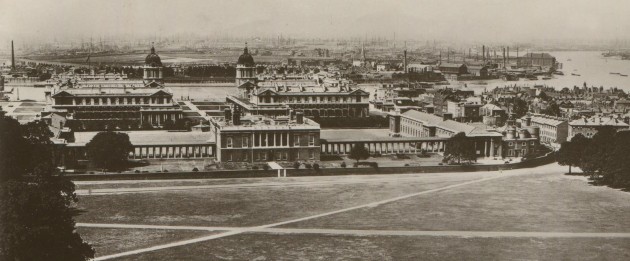
The Royal Hospital School with the Royal Naval College behind and Greenwich Park in front. The photo was taken in about 1870 from the Royal Observatory. The teaching block was at the left end of the colonnades (behind the trees), whilst the dormitories and school observatory with its prominent drum domes were in the wing at the right end of the colonnades. The Queen's House in the centre was where the headmaster and other senior staff lived. Following the school's move to Holbrook, Suffolk in 1933, the buildings were repurposed for the National Maritime Museum, (which was created by act of parliament in 1934). Detail from a postcard published by Henry Richardson

Charles Davidson the year after his election as a fellow of the Royal Society. Bromide print by Walter Stoneman, 1932. Another photo by Stoneman was published with his obituary (see below). � National Portrait Gallery, London. Reproduced under a Creative Commons Attribution-NonCommercial-NoDerivs 3.0 Unported (CC BY-NC-ND 3.0) licence (see below)
Davidson applied for a post a few days before his 15th birthday on 25 February 1890. He sat the exam on 4 March 1890 with three other candidates (RGO7/29). Of the four, just two were successful, Davidson and Thomas Claxton (who was assigned to the Magnetical and Meteorological Department and went on to become Director of the Royal Alfred Observatory, Mauritius). They both started work on 10 March 1890, arriving at the Observatory at a time of great change (RGO7/266). The Astronomer Royal, William Christie, was not only in the midst of expanding the number of large equatorials at his disposal, he was also embarking on a novel experiment to employ women professionals for the first time. The four women recruits, – Christie’s ‘Lady Computers’ – turned up for their first day of work just a month after Davidson had started. Their role was to carry out a photographic survey of the heavens with the newly commissioned Astrographic Telescope, measure the photographic paltes and reduce the data obtained. Although paid at a similar rate to the Boy Computers, (their pay ranged from £4 to £8 a month), they were vastly better qualified, having all studied mathematics at Cambridge – three at Newnham and one at Girton.
Davidson himself was assigned to work on miscellaneous astronomical reductions (RGO7/266). He obtained an observing certificate for the Transit Circle on 14 January 1891 and for the Altazimuth on 29 July 1891 (RGO7/136). Each of these would have given him a small pay rise and entitled him to be rostered for observing duties, for which an extra allowance was paid.
For various reasons, the women slowly started to leave. Although one new woman was taken on in 1891, a conscious decision was eventually made not to replace the others and to let the experiment come to a natural close. As a result, it became necessary to train up some of the boys as observers with the Astrographic Telescope. The first to be trained were Charles Davidson and Herbert Furner, who were awarded observing certificates on 1 December 1891 (RGO7/136). Of the two, only Davidson appears to have been assigned formally to carry out other work for the Astrographic Department, which at that time was superintended by one of the long standing Assistants George Criswick.
The traumatic events of 1894
In 1894, two events occurred that must have stayed with Davidson for the rest of his life. The first occurred at about 4.45 in the afternoon of Thursday 15 February 1894, when a small bomb exploded in Greenwich Park on the zigzag path that (in those days) climbed the slopes to the north-west corner of the Observatory. At the time of the explosion, it was being carried by Martial Bourdin, a French anarchist when lost his hand as a result and subsequently died. It is unclear either what the target was, or why the bomb went off when it did. In the account in the weekly magazine Black and White (below), it is suggested that Bourdin’s aim was to blow up the Gate Clock and that he accidently triggered the bomb too soon as he approached the Observatory. Other reports suggest that the bomb exploded as a result of him tripping on the path.
It seems likely that Davidson was not present at Observatory at the time of the explosion. His working day would either have ended either at 4.30, or at 1.00 if it was one of the days on which he was scheduled to observe. Given that the bomb exploded about half an hour before sunset, he would be unlikely to have reported so early for their evening duty even if it was one of his observing days. If he was in Greenwich at the time, it is likely that he would have heard the explosion.
The second incident was far more serious and occurred at the end of the year on 22 December. At 11.32 in the morning, the shutter of the Astrographic Dome, where he was at work printing reticules, was ripped off by the wind and fell into the courtyard below, breaking a few tiles and damaging the roof of the covered way by the entrance to the Airy Transit Circle on the way down. The ‘head piece’ however fell inside the dome where it just missed him (RGO7/29). This incident put the telescope out of action for two months while the dome was repaired. It came back into use on 22 February 1895.
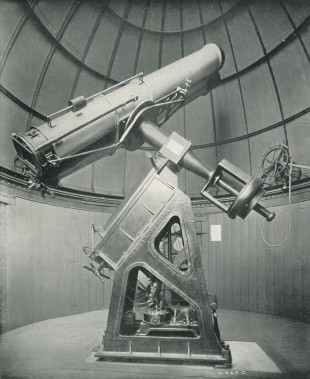
The Astrographic Refractor – the instrument on which Davidson learnt his astrophotography skills. Photo by the London Stereoscopic and Photographic Company c.1896, From the Greenwich Astrographic Catalogue, Volume 1, (HMSO, 1904)

Charles Davidson at the eyepiece of the Hodgson guiding telescope (G) of the 30-inch Reflector (R) during the photographic search for Halley's Comet in September 1909. An electric key (H) in his hand allowed him to finely adjust he rate of the driving clock (E). The exposing cord is marked (C) and the spectroscope, which is not in use, (S). Later copy of an illustration originally published in the 16 October 1909 edition of The Illustrated London News
No prospect of advancement
In 1895, when Davidson turned 20, there was absolutely no prospect whatsoever of him becoming an established member of staff. The only posts that ever became available were those at Assistant level. Not only were vacancies few and far between (normally dead men’s shoes) but more seriously for Davidson, those vacancies that had occurred since the early 1880s, had all been filled by Cambridge men with good degrees in mathematics. Given that the regulations required him to leave at the age of 23; he seems to have started the search for a job elsewhere. He resigned his post on 13 July 1895 to take up a post as 2nd Division Clerk (Local Government Board) (RGO7/266).
Restructuring the staff and the creation of a new grade intermediate grade
One of Christie’s gripes around this time was that he was unable to retain good members of staff like Davidson as there were no suitable established posts for them to fill. He had therefore been seeking to restructure the staffing by introducing a new grade of Established Computer. The Admiralty eventually agreed and six new posts were introduced at this level in the middle of 1896.
Davidson was permitted to apply and was taken back onto the staff on 1 June 1896 and fortunately (in the light of his later work) was not lost to science. Only four of the six posts were filled initially, with the others going to Bowyer, Edney and Rendell. Davidson was initially assigned to work back in the Astrographic department which had been taken over by Henry Hollis on Criswick’s retirement on 30 January 1896. His early participation in the Astrographic programme in 1891 put him in a good position for further advancement when two new photographic telescopes were brought on stream towards the end of the decade.
A career move to the Thompson Equatorial
In 1894, work began on what was to become known as the Thomson Equatorial. When completed, it consisted of three photographic telescopes – a 26-inch refractor, a 30-inch reflector and a 9-inch photoheliograph. It was gradually brought into use in 1898, but was not fully in use until 1900. The observers at that time were recorded in the Introduction to Greenwich Observations (1900) as Dyson (one of the two Chief Assistants), Davidson and Edney. Davidson was also put in charge of measuring the photographic plates taken with it (not the solar ones), together with the associated reductions. In 1901, he was also put in charge of the spectroscope during Dyson’s absence on an eclipse expedition to Sumatra. By the middle of 1902, he had been given resposnsibility for the entire telescope, a responsibility he retained until his retirement. When the Yapp 36-inch Reflector was brought on stream in 1933/34, he was put in charge of that as well. In the mean time, his last regular observation with the Airy Transit Circle seem to have been made in 1901.
1901 was also the year when Davidson was elected a fellow of the Royal Astronomical Society. He was proposed by Christie on 9 November 1900 and elected on 11 January 1901.
Promotion, marriage and family life
On Nash’s retirement at the end of December 1903, a number of promotions took place and the staffing complement was altered from five Assistants and two Established Computers (Higher Grade) to six Assistants and one Established Computer (Higher Grade). With effect from 1 January 1904, Bryant and Crommelin, were promoted to the Assistant level and Davidson was promoted to Established Computer (Higher Grade). As an Established Computer, Davidson’s pay scale went from £80–£190 with annual increments of £7. In his new grade, the salary scale went from £200–£300 with annual increments of £10. On his new salary, he was able to move from the two rooms he rented on the north side of Greenwich Park to a good sized house of eight rooms (excluding any bathrooms etc) in Egerton Road (now Drive) on the west side.

From 1899�1904, Davidson lived in two rooms on the first floor of the house on the right. Known then as 41 Park Street, it is known now as 41 Greenwich Park Street. Photo: April 2019
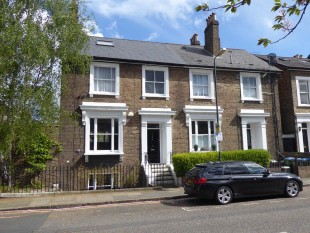
From 1905�1924, Davidson lived in the semi-detached house on the left. Known then as 21 Egerton Road, it is known now as 21 Egerton Drive. Photo: April 2019

From 1925 until after his retirement, Davidson lived at 65 Foyle Road (the semi-detached house in the centre). Photo: June 2012
In about 1908, Davidson married Eliza Louisa Stanford about whom little seems to be known except for the fact that she was born in Hong Kong, was about the same age as Davidson and seems to have been known as Louisa. He is believed to have had four children. Charles Stanford Davidson, who was born in 1909, was the oldest and Cecily Maud Davidson, who was born in 1913, the youngest.
On 30 May 1912, the Established Computers were renamed as Junior Assistants and the Higher Grade Established Computers as Junior Assistant (Higher Grade). Davidson himself was then promoted to the Assistant Grade on 3 September 1919 following the retirement of William Thackeray.
At the start of 1925, the family from the west side of Greenwich Park to a more spacious house with a bigger garden in Foyle Road on higher ground on the east side. This was a similar move from west to east that had been made by many of Davidson’s predecessors over the previous 50 or so years. Interestingly, the house, which was purchased freehold, appears to have purchased in the name of his wife (notice published on 30 December 1924 in the London Gazette). The reason for this is unknown, but given that the eclipse expeditions (see below) that Davidson had been on had not been devoid of danger, it may have been a precaution to make the legal side of things simpler should he disappear on one in the future.
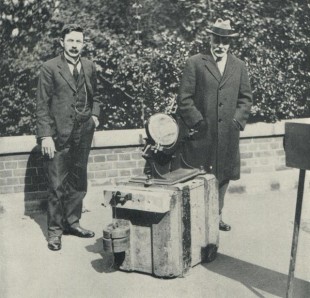
Davidson (left) with Dyson and the coelostat which was about to be taken to Giggleswick for the 1927 eclipse. The photo was taken on what is now known at the Gagarin Terrace outside the New Physical Building at Greenwich
Eclipse expeditions
As well as being responsible for the Thompson Equatorial, Davidson was also sent on eight eclipse expeditions. This sometimes meant being away for several month at a time. Probably the most famous was the 1919 expedition to Sobral in Brazil to test Einstein’s theory of relativity by measuring the deflexion of starlight as it passed the limb of the Sun. Click here to read more about the 1919 eclipse.
The next most famous was probably the 1927 eclipse expedition, which was the first solar eclipse to be visible from the landmass of Britain since 1724. For this, the Observatory sent a party to Giggleswick in Yorkshire. Although the weather was poor with cloud and high winds, along the eclipse path in Britain, the astronomers at Giggleswick were some of the few to have sufficient breaks in the weather to observe it.
Of the eight expeditions, the only one that was a complete wash out was the one to Brazil in 1912. Brief details of all eight expeditions are given in the table below:
Date |
Location |
Party |
Report |
|
| 1900, May 28 | Portugal (Ovar) | Christie, Dyson, Davidson & others* |
Click here to read more | |
| 1905, Aug 30 | Tunisia (Sfax) |
Christie, Dyson, Davidson, Sampson*, Atkinson*, Brett* |
Click here to read more | |
| 1912, Oct 10 | Brazil (Passa Quatro) |
Davidson, Eddington | Click here to read more |
|
| 1914, Aug 21 | Russia (Minsk) | Davidsin, Jones (Spencer Jones), Hepburn* | Click here to read more | |
| 1919, May 29 | Brazil (Sobral) |
Davidson, Crommelin | Click here to read more |
|
| 1926, Jan 14 | Sumatra (Benkoelen) |
Davidson, Stratton*, Barton* & others* |
Click here to read more | |
| 1927, Jun 29 | England (Giggleswick, Yorkshire) |
Davidson, Dyson, Jackson, Melotte, Woodman |
Click here to read more |
|
| 1932, Aug 31 |
Canada (Parent) |
Davidson, Jackson, Witchell, Slouka* |
Click here to read more |
* Not members of the Observatory staff
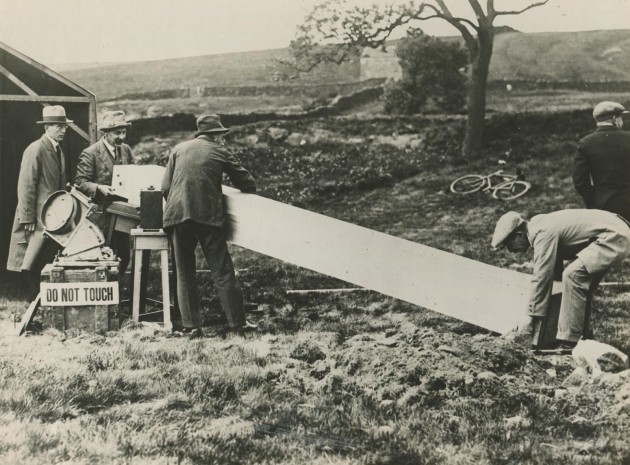
Setting up for the eclipse in Giggleswick. From left to right: Herbert Horrocks? (the former Isaac Newton Student and Smith's Prizeman from Cambridge, who had been at the Observatory since January and was about to take up the post of Chief Assistant at the Cape Observatory), Woodman (Foreman of the Observatory and in charge of the workshop), Mellotte (Junior Assistant, Higher Grade), Davidson (bending down and picking up the tube) and Dyson (Astronomer Royal)
Fellowship of the Royal Society
On 15 December, Davdson’s name was put forward for election as a fellow of the Royal Society. He was elected on 7 May 1931 and was one of very very few Observatory staff (apart from the Astronomers Royal and Directors) to be elected a fellow of the Royal Society while still actually being employed there.
He was proposed by Frank Dyson, seconded by Arthur Eddington and supported by John Stanley Plaskett; Hugh Newall, Francis William Aston, Joseph Larmor, Alfred Fowler and Harold Jeffreys. Of these eight, two (Dyson and Eddington) had worked or were working with him at the Observatory, four were members of the Observatory’s then Board of Visitors (Fowler, Larmor, Newell and Eddington), and two (Plasket and Jeffreys) would serve on the Board at a future date. The accompanying citation read as follows:
Distinguished as an Astronomer and Astrophysicist. Has taken an important share in the following investigations which have been largely entrusted to him: -
(1) Determination of the Solar Parallax from observations of Eros (1900).
(2) Photographic Magnitude of Stars to 9.0 in the Greenwich Section of the Astrographic Chart.
(3) Effective wave-lengths of stars from 80 degrees to the North Pole.
(4) Determination of Stellar Parallax.
(5) Spectro-photometric determination of the Colour Temperatures of Stars. Important photographic and spectroscopic work in many eclipse expeditions, particularly in 1919 when the bending of light by the sun’s gravitational field was verified, and in 1926 when the chromospheric spectrum was extended by him nearly to the limit imposed by atmospheric absorption.
Click here to view nomination form and citation as submitted.
Publications
As well as a number of scientific papers to his name, Davidson also contributed a chapter on Astronomical Photography to Photography as a scientific implement; a collective work by AE Conrady, Charles R Davidson and others. First published in 1923 in both London and New York, it went though a number of editions. Click here to read Davidson’s chapter.
Click here to access the scientific papers.
Retirement
When Davidson was promoted to Assistant level in 1919, he was the first boy computer to have risen to a permanent post at this level since the 1860s. Others soon followed and by 1927, all the Assistant posts (of which there were four at that time) were filled by his peers. This remained the case until 1936, when the first external appointment was made at Assistant level since 1892, following the retirement of William Bowyer (who was replaced by Humpry Smith). When Davidson retired on 31 August 1937, he was succeeded by Dr Alan Hunter and an era was rapidly drawing to a close.
On Davidson’s retirement, the then Astronomer Royal, Spencer Jones, made the following tribute to him, in his Report to the Board of Visitors for 1938.
‘It is not possible to state how much the Observatory has owed to Mr Davidson, who for many years was in charge of the various programmes of observations with the 26-inch refractor and the 30-inch reflector. With a flair for the design of apparatus, he was consulted on many matters of design outside his own department. He had an unusual degree of skill in the adjustment and testing of optical apparatus and would always obtain the best possible results out of any given equipment. The design and supervision of construction of apparatus for use by general eclipse expeditions from the Royal Observatory was entrusted to Mr Davidson.’
Obituary
Obituary by Richard Wolley (Astronomer Royal 1955-1972)
Note: much of the first paragraph of the above obituary contains significant amounts of incorrect information.
Acknowledgements
The following image is © National Portrait Gallery, London and reproduced under a Creative Commons Attribution-NonCommercial-NoDerivs 3.0 Unported (CC BY-NC-ND 3.0) licence.
Portrait of Charles Davidson. Bromide print by Walter Stoneman, 1932. National Portrait Gallery Object ID: NPG x167010.
© 2014 – 2025 Graham Dolan
Except where indicated, all text and images are the copyright of Graham Dolan